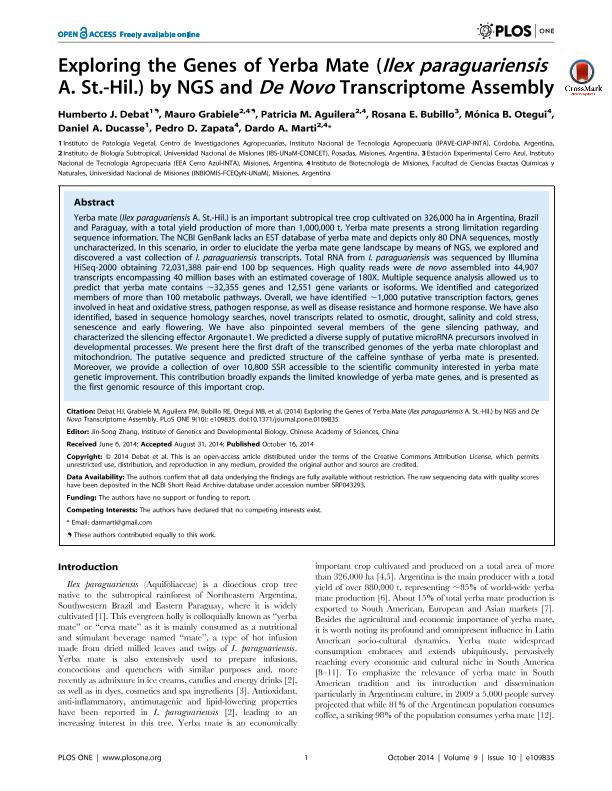Mostrar el registro sencillo del ítem
dc.contributor.author
Debat, Humberto Julio

dc.contributor.author
Grabiele, Mauro

dc.contributor.author
Aguilera, Patricia Mabel

dc.contributor.author
Bubillo, Rosana Elizabeth

dc.contributor.author
Otegui, Monica Beatriz

dc.contributor.author
Ducasse, Daniel Adrián

dc.contributor.author
Zapata, Pedro Dario

dc.contributor.author
Marti, Dardo Andrea

dc.date.available
2018-02-26T22:01:00Z
dc.date.issued
2014-10
dc.identifier.citation
Debat, Humberto Julio; Grabiele, Mauro; Aguilera, Patricia Mabel; Bubillo, Rosana Elizabeth; Otegui, Monica Beatriz; et al.; Exploring the genes of yerba mate (Ilex paraguariensis A. St.-Hil.) by NGS and de novo transcriptome assembly; Public Library of Science; Plos One; 9; 10; 10-2014; 1-16
dc.identifier.issn
1932-6203
dc.identifier.uri
http://hdl.handle.net/11336/37213
dc.description.abstract
Yerba mate (Ilex paraguariensis A. St.-Hil.) is an important subtropical tree crop cultivated on 326,000 ha in Argentina, Brazil and Paraguay, with a total yield production of more than 1,000,000 t. Yerba mate presents a strong limitation regarding sequence information. The NCBI GenBank lacks an EST database of yerba mate and depicts only 80 DNA sequences, mostly uncharacterized. In this scenario, in order to elucidate the yerba mate gene landscape by means of NGS, we explored and discovered a vast collection of I. paraguariensis transcripts. Total RNA from I. paraguariensis was sequenced by Illumina HiSeq-2000 obtaining 72,031,388 pair-end 100 bp sequences. High quality reads were de novo assembled into 44,907 transcripts encompassing 40 million bases with an estimated coverage of 180X. Multiple sequence analysis allowed us to predict that yerba mate contains ∼32,355 genes and 12,551 gene variants or isoforms. We identified and categorized members of more than 100 metabolic pathways. Overall, we have identified ∼1,000 putative transcription factors, genes involved in heat and oxidative stress, pathogen response, as well as disease resistance and hormone response. We have also identified, based in sequence homology searches, novel transcripts related to osmotic, drought, salinity and cold stress, senescence and early flowering. We have also pinpointed several members of the gene silencing pathway, and characterized the silencing effector Argonaute1. We predicted a diverse supply of putative microRNA precursors involved in developmental processes. We present here the first draft of the transcribed genomes of the yerba mate chloroplast and mitochondrion. The putative sequence and predicted structure of the caffeine synthase of yerba mate is presented. Moreover, we provide a collection of over 10,800 SSR accessible to the scientific community interested in yerba mate genetic improvement. This contribution broadly expands the limited knowledge of yerba mate genes, and is presented as the first genomic resource of this important crop.
dc.format
application/pdf
dc.language.iso
eng
dc.publisher
Public Library of Science

dc.rights
info:eu-repo/semantics/openAccess
dc.rights.uri
https://creativecommons.org/licenses/by-nc-sa/2.5/ar/
dc.subject
Transcriptome
dc.subject
Ilex Paraguariensis
dc.subject
Expression
dc.subject.classification
Otras Ciencias Biológicas

dc.subject.classification
Ciencias Biológicas

dc.subject.classification
CIENCIAS NATURALES Y EXACTAS

dc.title
Exploring the genes of yerba mate (Ilex paraguariensis A. St.-Hil.) by NGS and de novo transcriptome assembly
dc.type
info:eu-repo/semantics/article
dc.type
info:ar-repo/semantics/artículo
dc.type
info:eu-repo/semantics/publishedVersion
dc.date.updated
2017-11-16T14:51:46Z
dc.journal.volume
9
dc.journal.number
10
dc.journal.pagination
1-16
dc.journal.pais
Estados Unidos

dc.journal.ciudad
San Francisco
dc.description.fil
Fil: Debat, Humberto Julio. Instituto Nacional de Tecnología Agropecuaria. Centro de Investigaciones Agropecuarias. Instituto de Patología Vegetal; Argentina. Consejo Nacional de Investigaciones Científicas y Técnicas; Argentina
dc.description.fil
Fil: Grabiele, Mauro. Consejo Nacional de Investigaciones Científicas y Técnicas. Centro Científico Tecnológico Conicet - Nordeste. Instituto de Biología Subtropical. Universidad Nacional de Misiones. Instituto de Biología Subtropical; Argentina
dc.description.fil
Fil: Aguilera, Patricia Mabel. Consejo Nacional de Investigaciones Científicas y Técnicas. Centro Científico Tecnológico Conicet - Nordeste. Instituto de Biología Subtropical. Universidad Nacional de Misiones. Instituto de Biología Subtropical; Argentina
dc.description.fil
Fil: Bubillo, Rosana Elizabeth. Instituto Nacional de Tecnología Agropecuaria; Argentina
dc.description.fil
Fil: Otegui, Monica Beatriz. Universidad Nacional de Misiones. Facultad de Ciencias Exactas, Químicas y Naturales; Argentina
dc.description.fil
Fil: Ducasse, Daniel Adrián. Instituto Nacional de Tecnología Agropecuaria. Centro de Investigaciones Agropecuarias. Instituto de Patología Vegetal; Argentina
dc.description.fil
Fil: Zapata, Pedro Dario. Universidad Nacional de Misiones. Facultad de Cs.exactas Quimicas y Naturales. Departamento de Bioquimica Clinica. Laboratorio de Biotecnologia Molecular; Argentina. Consejo Nacional de Investigaciones Científicas y Técnicas; Argentina
dc.description.fil
Fil: Marti, Dardo Andrea. Consejo Nacional de Investigaciones Científicas y Técnicas. Centro Científico Tecnológico Conicet - Nordeste. Instituto de Biología Subtropical. Universidad Nacional de Misiones. Instituto de Biología Subtropical; Argentina
dc.journal.title
Plos One

dc.relation.alternativeid
info:eu-repo/semantics/altIdentifier/url/http://journals.plos.org/plosone/article?id=10.1371/journal.pone.0109835
dc.relation.alternativeid
info:eu-repo/semantics/altIdentifier/doi/http://dx.doi.org/10.1371/journal.pone.0109835
Archivos asociados
